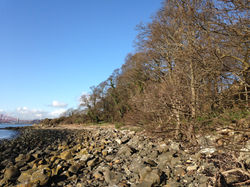New Oaks in Bathing House Wood
When a batch of young oak trees was donated to the group, the work to began to clear designated planting spots of ground covering ivy and other roots to reduce competition with the young trees and help them start to grow. Each of the three P7 classes took part in this often strenuous work.

The weather for Tuesday 3rd March could hardly have been better, a pleasant change from all the previous weeks of often stormy weather. All three P7 classes came down with their teachers to plant the oaks in the plots they had been preparing over the previous weeks.
In the morning the oaks were removed from the small plant pots in which they had been grown. They were sturdy little trees with lots of side branches with strong buds on many of them.

Ian Muir had raised them from acorns he had collected elsewhere in Scotland and had then generously donated them for our use. After the trees were brought down to the wood there was an opportunity to say something about the trees and their importance in the woodland and then each designated group of children selected one of the trees and took them to the plots marked out by canes and tape flags to carefully plant them.

The canes and marker flags will remain to help locate the trees when they need management to clear plants around them or give them water during dry spells.

There are already a few Oaks in the wood, one quite mature and 3 young trees about 20-25 years old. In addition, some oaks were among the trees planted by P7s in March 2015, and other donated oaks have been planted since then. Altogether these trees, from a range of different sources, should provide good genetic variation and allow for effective cross fertilisation once the trees are mature. Sadly, there are no Red Squirrels to aid in planting any acorns that are produced, but who knows what their distribution might be in 30 to 40 years’ time when these young trees start to mature. Oaks can live for a very long time, some very old ones are estimated to be over 1,000 years old. Most of the mature oaks in Scotland are in the 100+ range, having been grown as managed woodland for timber and bark, the latter being an important part of the leather tanning process.

Oaks are acknowledged to be the best UK tree for supporting a large range and number of insect species and this diversity is important to supply food for insect eating birds. Having more insects emerging as caterpillars or adults over the whole nesting season means that there is a chance that there will be sufficient insect food for nestlings to successfully complete their development. Several of the birds found in these woods, like the Wren, only eat insects, spiders and other invertebrates, and even the species that will come to garden seed feeders need insects to feed their nestlings.
This tree planting is just a part of the work that the P7s have been doing in our woods in relation to their study of ecology, and it also helps with their John Muir Award work. There are several areas in all three woods that, since 2015, groups of P7 pupils have also worked to clear ground smothering ivy. This has allowed a range of other native wildflowers and grasses to thrive. This work, along with the tree planting, is of great benefit to our woodland wildlife and, in addition, provides a more colourful and interesting experience for those walking the paths.


This close link with Donibristle Primary School is also valuable in enabling children to experience the inter-relatedness of nature at first hand, and it is to be hoped that their experiences will help them to form a balanced view of the importance of nature in their adult lives.
Let's hope it will be able to continue for many years to come.















































